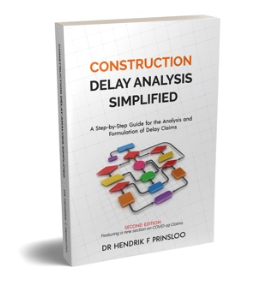CONSTRUCTION
STORYTELLING AS A TOOL OF PERSUASION IN DISPUTES
CHARACTERISTICS | FORMULATION | UTILIZATION

In the applied science world of construction, we often limit our view of storytelling as a form of entertainment that has no bearing on our success in an industry predicated on the creation of tangible physical objects. The role of stories in society and in our lives is of such significance that it even penetrates the concrete world of construction.
In this article, the persuasive power of storytelling is considered by reviewing applicable research and demonstrating how it can be applied to claims and disputes.

Dr Hendrik Prinsloo is an expert witness, researcher, and specialist in the analysis of construction delay claims
Intrinsic Power of Stories
Society, as we know it today, has been shaped by stories. Stories were
instrumental in the establishment of nations, the understanding of political concepts, and even took a central role in the development of our religious beliefs.
The power of this intrinsic force can also be seen in the constructs of the physical world.
In Egyptian society, the story that after death a second self will enter the afterlife was viewed with such veracity that it gave birth to the greatest construction project of all time that spanned over a thousand years.

The form and the functional components of the pyramids were informed by the story of the afterlife and the possibility to take earthly possessions on the journey to the eternal. Even in modern times, we experience the world through stories. Our actions are often dictated by stories. In the war in Ukraine, the Russian conscription call to enlist members of Russian society as soldiers was a failure and led to a mass exodus. During the second world war, there was no resistance to taking up arms. Why were ordinary Russians not willing to make the sacrifice this time around? The answer is simple, the story of invading Ukraine had nowhere near the veracity of the story of defending your country and way of life against an evil foe setting out to conquer the world.
Experimental Evidence – the eBay Experiment

Several research studies investigating the persuasive capabilities of stories found that stories are far more persuasive than the use of facts alone. Perhaps the most relatable of the studies is an informal experiment done by Rob Walker, a New York Times journalist.1
Rob started his experiment by acquiring two hundred low-cost items from eBay. The items with an average cost of $1.25 were not special in any way and included, for example, a motel room key, a plastic banana, and a small plastic horse’s head. The next step involved asking 200 authors to write a story about each item. The items were put up for auction on eBay but this time the item description included the stories about the items. Remarkable the 200 items purchased for $197 were sold for a total of $8000, a 6 395% increase in value. What caused this excessive increase in value? The answer is reflected in the only variable in the experiment – the addition of the story.
How to Harness the Power of the Story in Construction
How can we harness the power of the story in construction projects? Construction projects are granular and provide endless opportunities to use stories to help us in the journey to success.
But first, let us examine how to create successful stories. Ground-breaking research by the Swiss psychiatrist, Carl Jung, identified archetypes that form the basic building blocks of how human knowledge is passed down from generation to generation, often in the form of stories.
What is significant about this research is that Jung determined that the common archetypes were consistent in the stories, art and, symbols of people from different cultures, nations, and origins.
For stories to create resonance with your intended audience they should include some of these transcendent archetypes. Is it idealistic to think that any of these archetypes can be effectively utilized in any part of the concrete tangible world of construction? Certainly not, let’s take two simple examples, the first of a written claim from a contractor for time and cost, and the second, an example of how archetypes were utilized in arbitration.

Construction Claims
Construction Disputes
In a recent arbitration, a contractor was not able to complete the project as a result of the unwillingness of the owner to provide suitable design information and to approve change orders. It was very effective to embed the facts in a story, where the small contractor (everyman archetype) did everything in his power (caregiver archetype) to accommodate the countless requests for changes by the owner. The evidence of the reluctance of the owner to heed the continued requests for assistance by the contractor further enabled the owner to be portrayed as the villain (outlaw archetype) in the story that ultimately caused the failure of the project.
What make stories persuasive?
Stories have been embedded in human culture for thousands of years. The origins of stories can be traced back 30 000 years. But what has made stories so successful that it transcends the barriers of space and time? The answer is to some extent elusive, but research supports the proposition that the ability of stories to immerse the listeners in the story and evoke emotion may be factors contributing to the persuasive nature of stories. Effective stories are capable to transport listeners from their conscious reality to a realm created by the storyteller.
Research conducted by Phillip Mazzocco and Melanie Green3 Identified the following factors that contribute to narrative transportation and persuasiveness of stories:
Immersive Imagery
Images are an integral part of our thoughts. Immersive imagery in stories has the ability to remove the listener from their reality into the surreal world of the story, creating the potential to replace the listener’s preconceived ideas with new perspectives. This is perhaps one of the reasons why stories can be so effective as a tool of persuasion. Effective storytellers typically have the skill to evoke immersive imagery by using descriptive language. Using imagery that the listener is already familiar with can also be an effective technique to create a world of immersion. With the use of technology, we have unlimited access to images, making us less dependent on our ability to create immersive imagery by means of words alone.

Realism
It is fascinating that research identified realism as a characteristic of persuasiveness in stories. Realism in this context refers to the notion that stories should be understandable and relatable. An effective story should be easily understandable as an analogy that relates to the facts in question. In the development of the story, it should be considered what will be relatable to the intended audience. A typical experience shared by many people, a news event, or a well-known movie are good options to improve realism.
Structure
Stories that follow a common plot and structure of a beginning, middle, and end are more effective because of the familiarity in composition. Building suspense can also be very helpful to increase immersion.
Context
For stories to be truly immersive an appropriate context should be created. How the story is presented will influence the level of importance of the context. If the facts of the real-world circumstances can be conveyed in story format the context is to a large extent already in existence. If the story is independent of the real-world circumstances context should be created. This can be done by introducing and concluding the story with an explanation of how it relates to the facts.
CONCLUSION
Perhaps the most potent power of stories lies in their ability to generate emotion. A comprehensive study4 of research conducted over the past 35 years revealed that emotions constitute potent, pervasive, and predictable drivers of decision-making. Stories can be extremely effective in harnessing emotion to increase persuasiveness in construction claims and disputes.
References
- How storytelling increased the value of an eBay item by 6395% https://42courses.medium.com/how-storytelling-increased-the-value-of-an-ebay-item-by-6395- 60ca4f0280e
- Understanding Personality: The 12 Jungian Archetypes
https://conorneill.com/2018/04/21/understanding-personality-the-12-jungian-archetypes/
- Mazzocco, P.J., & Green, MC. 2011. Narrative Persuasion in Legal Settings: What’s the Story? American Society of Trial Consultants Volume 23, Issue 3, May 2011
- Jennifer S., & Lerner, Ye Li, Piercarlo Valdesolo, Karim S. Kassam. 2015. Emotion and Decision Making. Annual Review of Psychology 2015 66:1, 799-823
- Krause, R. J., & Rucker, D. D. 2020. Strategic Storytelling: When Narratives Help Versus Hurt the Persuasive Power of Facts. Personality and Social Psychology Bulletin, 46(2), 216–227.

